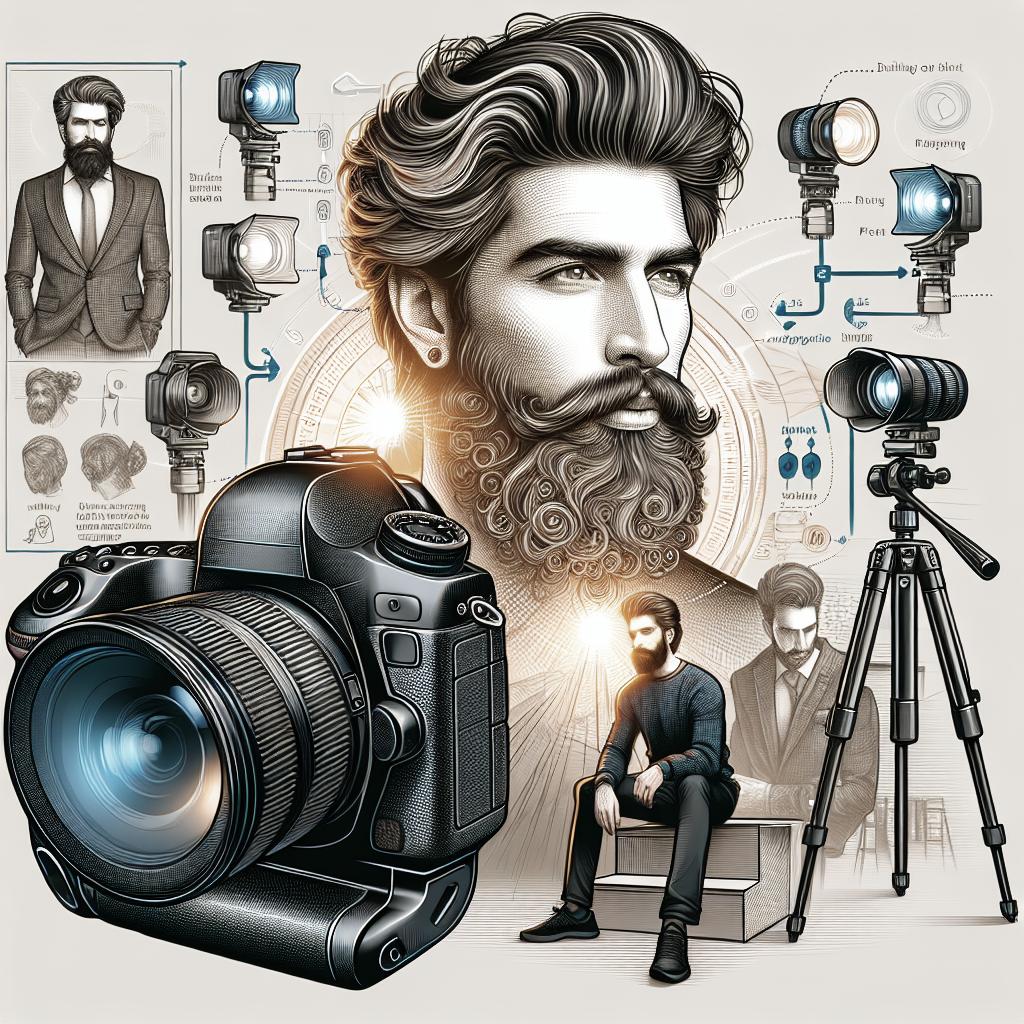<>
Portrait photography is as much an art as it is a science. Capturing the essence of a person, telling their story through an image, and evoking emotions in viewers requires a mixture of technical skill, creativity, and understanding of the human condition. Whether you’re just starting out or you’re looking to enhance your skills, this guide covers essential tips for taking stunning portrait photographs. From understanding your subject to mastering your equipment and experimenting with angles and props, these insights will help you elevate the quality of your portraits. Dive deep into professional practices and learn not just the “how” but also the “why” of each technique.
What is Portrait Photography?
Portrait photography is a genre of photography focused on capturing a person or group of people, often highlighting their personality and mood. It’s more than just taking a picture of someone; it’s about capturing a moment that speaks volumes about the subject’s character and emotions. Whether it’s a professional headshot, a candid family photo, or an artistic portrait, this form of photography aims to tell a story about the subject. The power of portrait photography lies in its ability to convey deep emotions and create a connection between the subject and the viewer. It can be planned, with the use of controlled lighting and carefully chosen settings, or spontaneous, capturing unguarded, natural moments. Each portrait tells a unique story, offering a glimpse into the life and essence of the subject.
Portrait photography tips: How to take good portraits
1. Get to know your subject
Building rapport with your subject is critical. Spend some time talking to them, getting to know their likes, dislikes, and what makes them comfortable. This interaction will help you understand how to bring out their best expressions and capture their personality authentically. A relaxed and comfortable subject will likely result in more natural and engaging photographs. Make them feel at ease by being friendly and approachable. This doesn’t just help with the photoshoot, but it also reflects in the final images, making them more appealing and emotive.
2. Scout your location
Location scouting is an integral part of portrait photography. The background should complement the subject and enhance the story you’re aiming to tell. Whether it’s a serene park, a bustling city street, or a cozy indoor setting, the location sets the mood for the portrait. Visit potential locations ahead of time to observe the lighting conditions and identify interesting features. This preparation allows you to plan your shots better and make the best use of natural or artificial light available.
3. Know your camera
Familiarity with your camera’s settings and functions is crucial. Learn about the ISO, shutter speed, aperture, and how they interplay to create a well-exposed image. Practice different settings to see how they affect your shots and become comfortable switching between them quickly. A good portrait photographer can adjust their camera on the fly to capture unexpected moments. Taking the time to master your gear will ensure you’re always ready to get the perfect shot, no matter the situation.
4. Keep samples
Having a portfolio of sample shots can be quite beneficial. It gives your subjects an idea of what to expect and helps them understand your style. Additionally, you can use these samples to experiment with new techniques and evaluate what works best. Reviewing your previous work also allows you to identify areas for improvement. Continuous learning and adapting are key to becoming a better photographer.
5. Mind the eyes
The eyes are the windows to the soul, and this couldn’t be truer in portrait photography. Ensure the eyes are in sharp focus and well-lit, as they are often the focal point of a portrait and the first thing viewers notice. Catchlights – the reflective highlights in a subject’s eyes – can add depth and a lively sparkle to the portrait. Positioning your subject where light can shine directly into their eyes or using a reflector can help achieve this effect.
6. Evoke genuine expression
Getting genuine expressions from your subject is vital. Encourage them to think about something they love or tell a funny story to spark a real smile or emotion. Capturing these genuine moments makes for more compelling and relatable portraits. Creating a comfortable and fun environment can naturally lead to authentic expressions. Remember, your subject’s body language and facial expressions are crucial in telling their story.
7. Change angles
Experimenting with different angles can yield more dynamic and interesting portraits. Don’t stick to eye-level shots; try getting down low, or high up, and see how the perspective changes the image. Different angles can emphasize different aspects of your subject. For example, a shot from below can make a subject appear more powerful and confident, while a shot from above can make them look more approachable and delicate.
8. Use props
Props can add an extra layer of interest and help tell a more complete story about your subject. They can be anything from a hat, a book, or even an instrument – something that represents the person’s interests or personality. Using props can also make your subject more comfortable and give them something to interact with, adding natural movement and expressions to the photo.
9. Shoot in RAW and B&W
Shooting in RAW format provides greater flexibility in post-processing. It captures more detail and enables you to adjust exposure, white balance, and other settings without losing quality. Black and white portraits have a timeless and classic look. Stripping away the color focuses the viewer’s attention on the subject’s expressions and the play of light and shadow, often resulting in more emotionally powerful images.
10. Use contrast to draw the viewer in
Contrast is an effective way to make your subject stand out. This can be achieved through lighting, clothing, or background elements. High contrast between the subject and the background can make the portrait more striking. Balancing contrast while ensuring the subject remains the focal point is an art. Experiment with different lighting setups and backgrounds to see how contrast can enhance your portraits.
11. Get in close
Sometimes, getting in close can reveal more about the subject. Close-up shots highlight details that tell their own story, whether it’s the texture of the skin, a freckle, or the intensity in the eyes. These intimate shots provide a different perspective and can make the viewer feel more connected to the subject.
12. K.I.S.S.
Keep It Simple, Silly (K.I.S.S.) is a principle that often works well in portrait photography. Avoid overly complicated setups or too many elements that might distract from the subject. A simple background, natural light, and a straightforward pose can sometimes produce the most powerful portrait, allowing the viewer to focus solely on the subject.
13. Fill in the frame
Filling the frame with your subject can create a more intimate and detailed portrait. This technique leaves no room for distraction, directing all attention to the subject’s face and expression. Use this approach for a headshot or close-up portrait to emphasize the details and emotions captured.
14. Embrace shadows
Shadows can add depth and drama to your portraits. Play with light and shadow to create a mood or highlight different aspects of your subject’s face. Don’t be afraid to experiment with shadow; it can transform a flat image into a three-dimensional, visually intriguing photo.
15. Invest in a good camera
While skills and creativity are paramount, having a good camera can significantly impact the quality of your portraits. Investing in a camera with a high-resolution sensor and good low-light performance will allow you to capture sharper and more detailed images. Consider also investing in quality lenses, as they play a crucial role in the overall look and quality of your photographs.
Portrait Photography: Frequently Asked Questions
What Makes a Good Portrait Photo?
A good portrait photo captures the essence of the subject. It effectively uses lighting, composition, and background to highlight the subject’s personality and emotions. Authentic expressions, sharp focus on the eyes, and a clean, uncluttered background are common elements of a captivating portrait. Ultimately, a good portrait should resonate with viewers and tell a story about the subject. Whether it’s dramatic, serene, or joyful, the emotional connection is what makes a portrait stand out.
How Do I Start Portrait Photography?
Starting in portrait photography involves several steps. Begin by learning the basics of photography, such as exposure, composition, and lighting. Practice with friends or family to build your skills and confidence. Invest in a good camera and lens, but remember that even a smartphone can take great portraits with the right techniques. Join photography communities, study the work of professionals, and continuously practice and experiment.
How to Make Your Portrait Subject Comfortable?
Making your subject comfortable begins with building a rapport. Spend time talking with them before the shoot, explaining what you aim to achieve and listening to their preferences. Keep the atmosphere light and relaxed, and be patient. Giving your subject specific, gentle guidance on posing can help them feel more at ease. Show them some shots during the session to boost their confidence and involve them in the creative process.
What are Different Styles of Portrait Photography?
Portrait photography encompasses many styles, including traditional, environmental, candid, and artistic. Traditional portraits are often posed with controlled lighting in a studio setting. Environmental portraits capture subjects in their natural surroundings, telling a story through the background elements. Candid portraits are unposed and capture spontaneous moments, often reflecting genuine emotions. Artistic portraits focus on creativity, often incorporating unique angles, props, or post-processing techniques to achieve a specific effect or mood.
| Aspect | Description |
|---|---|
| Knowing Your Subject | Build rapport, understand personality for authentic expressions. |
| Location Scouting | Choose backgrounds that complement and enhance the subject’s story. |
| Mastering Your Camera | Familiarize with settings to adjust quickly and capture perfect shots. |
| Keeping Samples | Use previous work to guide and inspire subjects. |
| Focusing on Eyes | Ensure sharp focus and good light to draw viewers in. |
| Evoking Expressions | Encourage subjects to think of happy or meaningful thoughts. |
| Using Angles | Experiment with perspectives to find the most flattering views. |
| Incorporating Props | Add interest, enhance storytelling, provide subjects with comfort. |
| Shooting in RAW & B&W | Allows greater post-processing flexibility, classic look for deeper impact. |
| Using Contrast | Highlight subject by balancing light and dark elements. |
| Close-Up Shots | Focus on intimate details for an emotional connection. |
| Simplifying Setup | Avoid distractions, focus on subject for powerful portraits. |
| Filling the Frame | Eliminate distractions, draw full attention to subject. |
| Embracing Shadows | Add depth, drama, and interest to portraits. |
| Investing in Equipment | Higher quality camera and lenses enhance photo quality. |


